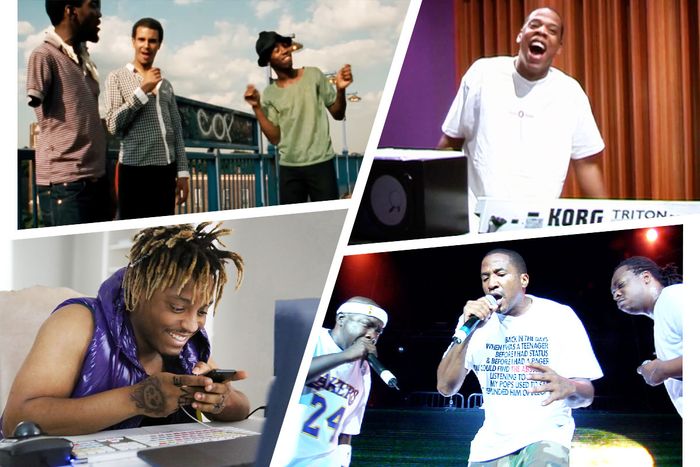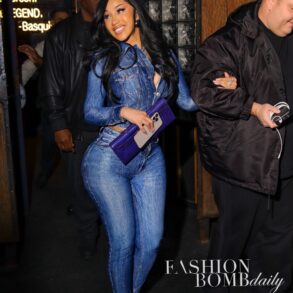
Photo-Illustration: Vulture
Today’s music documentaries increasingly read as little more than slick, self-congratulatory packages produced by the subjects themselves, with a series of friendly talking heads sharing stories laden with hyperbole and mythology. These films rarely show us why these stories are worth telling in the first place. Where is the sweat? Where are the fuck-ups and early drafts? Where are the breakthroughs, insights, and innovations happening on the page or in the booth or behind the boards? Where is the process?
Rock music has received plenty of praise for its own great “process” docs over the years (The Last Waltz, Stop Making Sense), but there’s far less attention paid to ones about hip-hop. With rap unofficially turning 50 this year, it’s time to change that. The documentaries below don’t skimp on the work: the combination of discipline and talent it takes to become a great DJ, what a style of dance can mean to a culture and a community, the mess that comes with keeping together a band of brothers who have achieved global success. These films aren’t just great works of art about making great art; they are each a testament to a director given the gift of unfiltered access.
A pair of important films that don’t quite qualify for this list but are worth highlighting all the same. Blurring the line between documentary and narrative feature, Wild Style and Downtown 81 are compelling sociological profiles of early-1980s hip-hop, with the former focused on its home in the Bronx and the latter showcasing the downtown scene where rap blended with New Wave and art theory. Wild Style is ostensibly a rom-com about two young graffiti writers (legends Lee Quinones and Lady Pink), while Downtown 81 is a fairytale about Jean-Michel Basquiat trying to make rent. Both take a circuitous path through their respective narratives to show us what life was like for a cast of nonactors in the parks, streets, and clubs of the Bronx and the Lower East Side.
Or, the making of a megalomaniac. Coodie Simmons and Chike Ozah’s epic is a four-and-a-half-hour interrogation of how Kanye transformed from a bright and burning light of boundless creativity to a canceled, divorced Trump supporter spouting self-destructive conspiracy theories. Coodie is just trying to understand what exactly happened to his one-time good friend. In vintage Kanye fashion, the rapper hired the two young music-video directors to document his early-2000s journey as a solo artist. Watch as Kanye uses the sheer power of hubris to make it in the face of incredible odds: a weird name, goofy concept songs in an era of bland G-Unit-powered mall rap, a career-threatening broken jaw he suffered in an L.A. car accident, recording College Dropout without a production budget. You understand there’s a reason it was so hard for Kanye to get on. There wasn’t, and still isn’t, precedence for who he was or what he became, but we can see it happening in real time. As Coodie loses touch with Kanye after the Glow in the Dark tour, he comes to the somewhat armchair-psych conclusion that losing his mother and not properly grieving her loss was responsible for the artist’s deeply disturbed state. The conclusion is debatable, but it aligns with the incredible hours of footage Coodie and Chike collected over the years, including heartbreaking moments shared between a mother and her son.
Tommy Oliver’s tragic profile of Juice WRLD opens with the late rapper shirtless and staring into the camera while performing an improvised three-minute verse. It sets the tone for this painfully honest portrayal. We follow the young star through all the beats in a burgeoning artist’s career: radio interviews, fucking around in the studio, spinning fables that display his improvisational gifts, meet and greets with heroes backstage where he’s unafraid of being an unabashedly starstruck teen. It’s not just a portrait of a tremendous talent gone too soon, but a document that explains how he briefly became one of the most influential creative forces of his generation.
The legendary rap crew famously had issues with director and established bonehead Michael Rappoport’s film. Unfortunately for Tribe, it’s a fantastic movie, honoring the group and their legacy as one of hip-hop’s most beloved and consistent collectives. The “process” here is a behind-closed-doors look at what goes into maintaining a group over a lifetime and at a family trying to stay together. As we watch Phife Dawg and Q-Tip snipe at each other, scratching at their old wounds and airing pent-up grievances, the audience begins to understand why artists and celebrities have become so sparing and selective with unfettered access — and why they still should grant it. When you don’t have control of your narrative, things will end up onscreen you may not be entirely happy with. But the greatest works of art in this medium demand nothing less.
In one of the few examples of a verité hip-hop film, director Adam Bhala Lough captures how Wayne rewrote the rules of rap for the streaming age. Lough pulls it off by shadowing Wayne for months, including during what was supposed to be a victory lap of a European tour. Instead it becomes a melancholy document about an addict, equally in the thralls of drugs and work, struggling to acknowledge the deep trauma that he had been carrying for over a decade. Wayne is a fascinating subject, quiet and withdrawn while high on a cocktail of weed and lean. That is until he unpacks his mini mobile studio, opening his mouth and composing brilliant, timeless verses he’s practically editing in real time. Much like Tribe with Rappaport, Wayne and manager Cortez Bryant were unhappy with Lough’s final product, leading to the documentary being initially shelved and still underseen.
The rarest of animals: a compulsively rewatchable body pillow of a documentary. We watch as Chappelle attempts to pull off an impossible event: An impromptu music festival featuring the Soulquarians and Soulquarian-adjacent collective. In the process, he sweeps up a young Kanye West to open, along with Dead Prez, Fred Hampton Jr., the reunited Fugees, and an Ohio marching band. They all end up in front of a reclaimed trap house in Bed-Stuy for a magical afternoon- and evening-long celebration of rap and community. The concert was as strange, unusual, and ambitious as Chappelle’s groundbreaking television show, and while it’s ostensibly a music-performance doc, the real stars are found in Chappelle’s interactions with random people.
The most visually stunning documentary on this list. But photographer David LaChapelle’s film is more than just something pretty to look at. It’s a story about clowning and krumping, one convulsive dance form that evolved out of the other, with roots in breakdancing. In telling that story, LaChapelle introduces us to the counterculture that rose up around it, using clowning as a resistance to systemic violence in a small, imperiled Los Angeles community. It’s about the power of dance in a dire and desperate environment as a group of incredible athletes and performers struggle to break an ugly generational legacy and forge their own way forward.
This film doubles as a concert doc of Jay-Z’s legendary MSG “retirement” show and a procedural about the making of his then-final project, The Black Album. It’s basically a 90-minute episode of This Is Your Life, a portrait of the artist when he was still an artist. This was the last moment music had Jay’s full attention. The particular collective nature of the The Black Album complements the format. Jay goes from producer to producer, reuniting with the collaborators, influences, and friends that defined his career for one last job. It’s also an inside look at how rappers and producers met and made music on the highest possible level in the aughts, before you’d just email a beat to some artist you DMd on Instagram. There are too many great moments to list them all, but the standouts include Jay finding the “Dirt Off Your Shoulder” beat with Timbaland and Jay improvising the short play with the southern cop for “99 Problems” as Rick Rubin and Mike D look on in awe.
This film uses the talking-head format but doesn’t lean on it. Freestyle features a murderers’ row of “rappers’ rappers” in exploring what the act of spontaneous rapping actually is. We see Black Thought with Questlove, beatboxing and pointing out random shit on the ground as subjects for Thought to freestyle around; the classic Biggie battle freestyle on the corner of Quincy and Bedford; and footage from Craig G’s historic battles with Supernatural that play like Ken Burns covering the Spotsylvania Courthouse. The film lives as a pure tribute to MCs who have slipped through the cracks of history because their unique skill sets didn’t translate to a conventional career.
Can a DJ get some? This love letter about craft and discipline operates like a ’90s skate-video highlight reel. It features interviews and footage with the gods and legends of turntablism from a time before the DJ became a glorified mixtape host with a Serato app and working your deck was an art: Grand Wizard Theodore, Mix Master Mike, DJ Premier, Z-Trip, The X-ecutioners, Beat Junkies, Qbert, Babu, and Melo-D. It’s a film about the history and the continued evolution of the sport, featuring long, uncut shots of practiced, skilled, calloused, and dusty hands working the crossfader and dancing with the needle.
Sometimes a great documentary is simply about being in the right place at the right time. This is one of the many broad-strokes films that are simply about rap as a whole, prophetically catching Biggie, Warren G, Snoop Dogg, Naughty by Nature, and Wu-Tang Clan, among others, as rising stars doing tear-down live performances.
The original hip-hop documentary. The film digs into the culture and nuance of graffiti in the early ’80s, reporting from the front lines of an internecine war between the artists throwing up accomplished, beautiful wild styles and the posers who got notoriety by trolling their art. It articulates a central tenet to all art: a painstaking (and in this case, literally, life-risking) dedication to creating quality work. That it’s being held in this community of brilliant, soulful, spray-paint-boosting Bronx teenagers as their parents look on in horror is nothing short of a humanity-affirming testament to the eternal power and importance of art. None of this would’ve been possible without directors Henry Chalfant and Tony Silver’s yearslong dedication to embedding with these writers and the fact that they respect their audience enough to leave it all onscreen.








